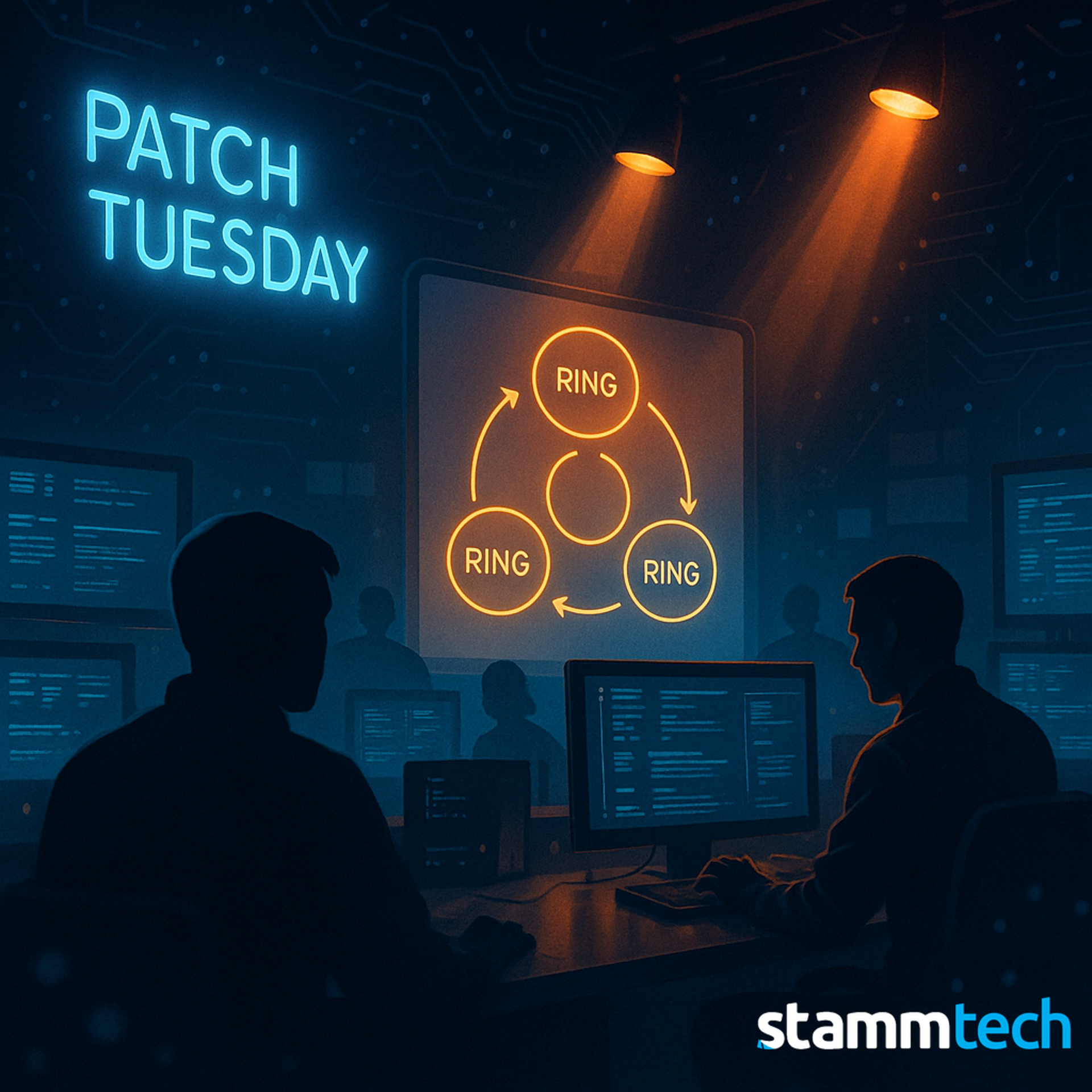TL;DR
- Patch Tuesday = the second Tuesday every month, when Microsoft ships cumulative security/quality updates (“B release”).
- We deploy in rings (IT → pilot → broad), monitor live, and rollback fast if needed. Intune update rings and gradual rollout policies make this predictable.
- Known Issue Rollback (KIR) and Safeguard holds reduce risk by auto-mitigating known issues or pausing affected devices.
- Guardrails: no patching during mission-critical windows, scheduled restarts after hours, and a documented escalation/rollback path. Update-ring settings control timing, deadlines, and restart behavior.
What Patch Tuesday actually is (and why SMBs should care)
Microsoft publishes a monthly, cumulative security update on the second Tuesday; it includes new fixes plus earlier non-security preview content. Skipping a month stacks risk and technical debt.
Our behind-the-scenes rollout at Stamm Tech
1) Stage & assess
- Review release notes, severity, known issues, and app/driver dependencies.
- Identify devices or departments with higher blast radius (finance, production, front-of-house).
- Confirm vendor guidance for EDR/AV, VPNs, and key line-of-business apps.
2) Ring deployments (gradual rollout)
- Ring 0 (IT/engineering): same day—shake out obvious issues.
- Ring 1 (pilot users / select departments): 24–72 hours later.
- Ring 2 (broad fleet): after ring 1 health checks pass.We use Intune update rings and gradual rollout options to pace installs and control deadlines/restarts.
3) Monitor in real time
- Watch install success rates, reboot status, and user tickets.
- Track Microsoft release health signals such as Safeguard holds that stop affected devices from receiving an update until a fix is validated.
4) Rollback if needed
- If a non-security regression appears, Microsoft’s Known Issue Rollback (KIR) can revert the specific change while preserving the rest of the update; we can also uninstall the update on impacted devices and pause the ring.
5) Guardrails (“do not patch during X”)
- Freeze windows around payroll, end-of-month, major events, or migrations.
- Use update-ring scheduling/restart controls and set deadlines/active hours so restarts land after hours.
- Maintain an exceptions list (kiosks, production machines) with added monitoring.
What “good” looks like (checklist)
- Rings defined with clear success criteria between stages
- Update-ring policy: deferrals, deadlines, restart behavior configured
- After-hours reboot plan & user comms template
- Visibility: dashboards for install status, failure codes, and ticket watch
- Rollback playbook: KIR awareness + uninstall steps + pause policy
- Exceptions: devices with special handling and a faster EDR watch
Common mistakes (and fixes)
- All-at-once updates → Use rings to limit blast radius.
- Unplanned reboots → Configure deadlines/restart settings and communicate.
- Ignoring known issues → Respect Safeguard holds; don’t force installs past them.
- No rollback path → Document KIR/rollback steps and who signs off.
Implementation quick start (90 minutes)
- Define rings & groups (Ring 0/1/2).
- Create Intune update rings with appropriate deferrals/restart deadlines.
- Map critical “do not patch” windows; schedule after-hours reboots.
- Ship to Ring 0; monitor; advance to Ring 1 if healthy.
- Watch for Safeguard holds; advance to Ring 2 once green.
- Keep rollback playbook handy (KIR/uninstall/pause).
FAQs
How many rings do we really need?Three is a practical baseline (IT → pilot → broad). Intune update rings and rollout options make this easy to manage without a ton of overhead.
What’s the difference between “quality” and “feature” updates?Quality updates are the monthly cumulative security/bug-fix releases (Patch Tuesday); feature updates are larger OS upgrades you can roll out gradually and are subject to Safeguard holds if issues are detected.
Can we just rely on Microsoft to “auto-fix” bad patches?Sometimes. KIR can automatically revert a specific non-security change, but you still need rings, monitoring, and an uninstall/pause plan for edge cases.
How do we avoid mid-day restarts?Use update-ring restart/deadline settings and set active hours so deadlines don’t collide with business hours; schedule reboots after hours and communicate the window.
What if a device is blocked from updating?That’s often a Safeguard hold—Windows pauses the offer until Microsoft validates a fix, then resumes. Don’t force it unless you’ve tested a mitigation.
